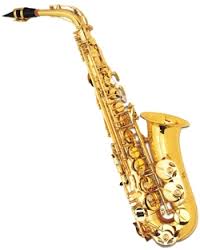
Musical instruments are grouped into families based on how they make sounds. In an orchestra, musicians sit together in these family groupings. But not every instrument fits neatly into a group. For example, the piano has strings that vibrate, and hammers that strike. Is it a string instrument or a percussion instrument? Some say it is both!
Brass instruments are made of brass or some other metal and make sound when air is blown inside. The musician's lips must buzz, as though making a "raspberry" noise against the mouthpiece. Air then vibrates inside the instrument, which produces a sound.
Brass instruments include trumpet, trombone, tuba, French horn, cornet, and bugle.
Most percussion instruments make sounds when they are hit, such as a drum or a tambourine. Others are shaken, such as maracas, and still others may be rubbed, scratched, or whatever else will make the instrument vibrate and thus produce a sound
Percussion instruments include drums, cymbals, triangle, chimes, tam-tam, glockenspiel, timpani, bells, and xylophone
Yes, the sounds of string instruments come from their strings. The strings may be plucked, as in a guitar or harp; bowed, as with a cello or a violin; or struck, as with a dulcimer. This creates a vibration that causes a unique sound.
Stringed instruments include the violin, viola, cello, bass, harp, and dulcimer.
Woodwind instruments produce sound when air (wind) is blown inside. Air might be blown across an edge, as with a flute; between a reed and a surface, as with a clarinet; or between two reeds, as with a bassoon. The sound happens when the air vibrates inside.
Woodwind instruments include flute, piccolo, clarinet, recorder, bassoon, and oboe.
Brass instruments are made of brass or some other metal and make sound when air is blown inside. The musician's lips must buzz, as though making a "raspberry" noise against the mouthpiece. Air then vibrates inside the instrument, which produces a sound.
Brass instruments include trumpet, trombone, tuba, French horn, cornet, and bugle.
Most percussion instruments make sounds when they are hit, such as a drum or a tambourine. Others are shaken, such as maracas, and still others may be rubbed, scratched, or whatever else will make the instrument vibrate and thus produce a sound
Percussion instruments include drums, cymbals, triangle, chimes, tam-tam, glockenspiel, timpani, bells, and xylophone
Yes, the sounds of string instruments come from their strings. The strings may be plucked, as in a guitar or harp; bowed, as with a cello or a violin; or struck, as with a dulcimer. This creates a vibration that causes a unique sound.
Stringed instruments include the violin, viola, cello, bass, harp, and dulcimer.
Woodwind instruments produce sound when air (wind) is blown inside. Air might be blown across an edge, as with a flute; between a reed and a surface, as with a clarinet; or between two reeds, as with a bassoon. The sound happens when the air vibrates inside.
Woodwind instruments include flute, piccolo, clarinet, recorder, bassoon, and oboe.
Identifying Instruments and Sounds
|
|
|
|
|
Introducing! The Orchestra
|
|
|